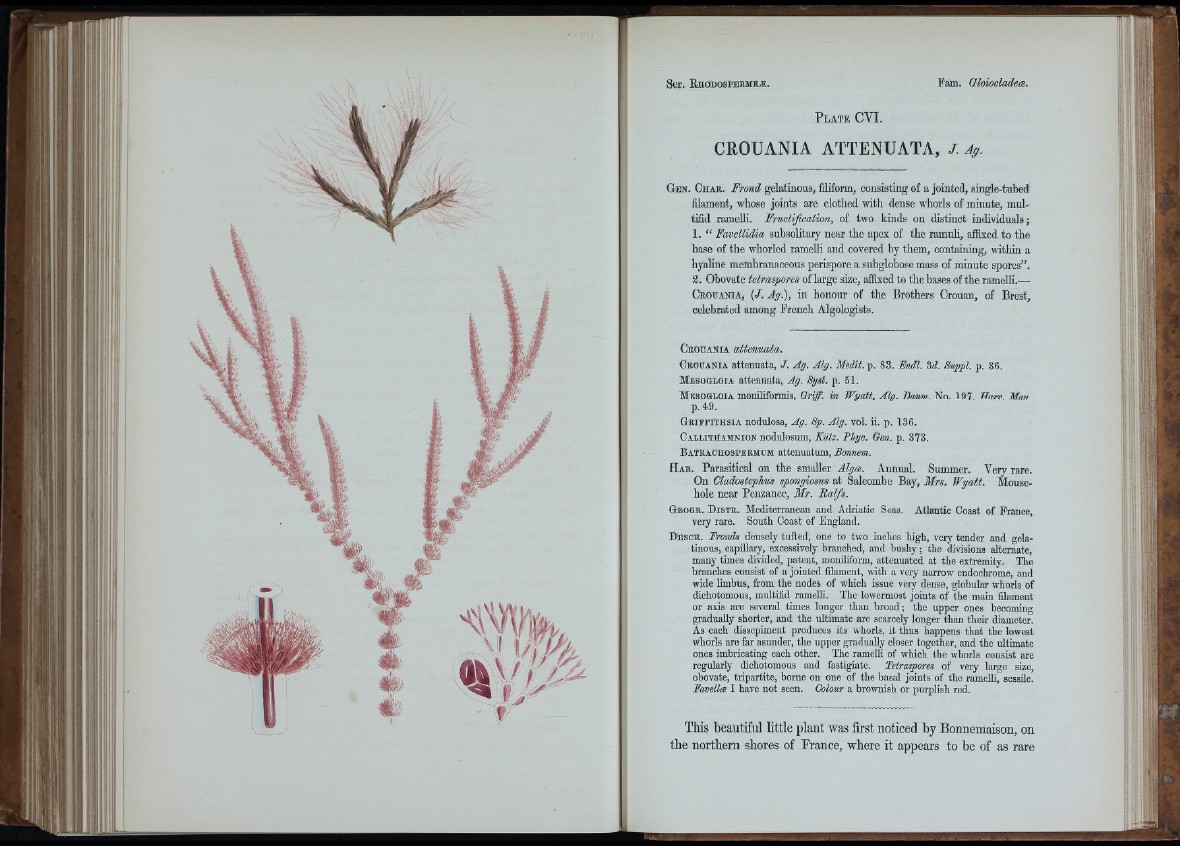
P l a t e CVI.
CROUANIA ATTENUATA, /. Jg.
G e n . C h a r . Froud gelatinous, filiform, consisting of a jointed, single-tubed
filament, whose joints are clothed with dense whorls of minute, multifid
ramelli. Frnctification, of two kinds on distinct individnals;
1. “ Favellidia snbsoUtary near the apex of the ramuli, affixed to the
base of the whorled rameUi and covered by them, containing, within a
hyaline membranaceous perispore a subglohose mass of m inute spores” .
2. Obovate tetraspores of large size, affixed to the bases of the ramelli.—
C r o u a n ia , {J. A g .), in honour of the Brothers Crouan, of Brest,
celebrated among French Algologists.
C r o u a n ia attenuata.
Cr o u a n ia attenuata, J . Ag. Alg. Medit. p. 8 3 . Endl. 3d. Suppl. p. 3 6 .
M e so g l o ia attenuata, Ag. Sgst. p . 51.
M e s o g l o i a moniliformis. Griff, in Wyatt, Alg. Banm. No. 1 9 7 . Bare. Man
p . 4 9 .
G r i p f i t h s ia n o d u lo s a , Ag. Sp. Alg. vol. ii. p . 1 3 6 .
C a l l it h a m n io n n o d u lo sum , Kiitz. Phyc. Oen. p . 3 7 3 .
Batraohospermum attenuatum, Bonnem.
H a b . Parasitical on the svm&sc Algee. Annual. Summer. Very rare.
On Cladostephus spongiosus at Salcombe Bay, Mrs. Wyatt. Mouse-
hole near Penzance, Mr. Rolfs.
G e o g b . D is t r . Mediterranean and Adriatic Seas. Atlantic Coast o f France,
very rare. South Coast of England.
Desor. Eronds densely tufted, one to two inches high, very tender and gelatinous,
capillary, excessively branched, and bushy; the divisions alternate,
many times divided, patent, moniliform, attenuated at the extremity. The
branches consist of a jointed filament, with a very narrow endochrome, and
wide limbus, from the nodes of which issue very dense, globular whorls of
dichotomous, multifid ramelli. The lowermost joints of the main filament
or axis are several times longer than broad; the upper ones becoming
gradually shorter, and the ultimate are scarcely longer than their diameter.
As each dissepiment produces its whorls, it thus happens that the lowest
whorls are far asunder, the upper gradually closer together, and the ultimate
ones imbricating each other. The ramelli of which the whorls consist are
regularly dichotomous and fastigiate. Tetraspores of very large size,
obovate, tripartite, borne on one of the basal joints of the rameUi, sessile.
Favella I have not seen. Colour a brownish or purplish red.
This beautiful little plant was first noticed by Bonnemaison, on
the northern shores of France, where it appears to be of as rare